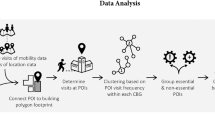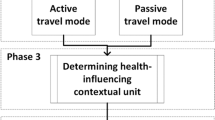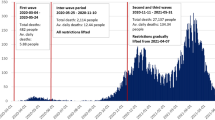Abstract
A human-centric approach to assessing flood exposure moves beyond traditional spatial assessment by quantifying flood exposure based on life activity. This novel method characterizes flood exposure by measuring dwell time in flood-prone areas, using fine-resolution, anonymized smartphone data. Comparative analysis across 18 US cities reveals important disparities in life activity flood exposure (LAFE) and highlights the influence of urban forms and structures on LAFE. Furthermore, the research uncovers bimodal distributions in LAFE, indicating disparities even among cities with similar spatial flood risks. By focusing on the effect of daily human activities in flood-prone areas, this approach offers a more comprehensive understanding of flood impacts on daily activities and socioeconomic factors. The findings provide urban scientists and flood risk managers with a practical tool, underscoring the importance of human activity patterns in flood risk assessment, and offer valuable insights for enhanced analysis of flood exposure and risk.
This is a preview of subscription content, access via your institution
Access options
Subscribe to this journal
Receive 12 digital issues and online access to articles
$119.00 per year
only $9.92 per issue
Buy this article
- Purchase on Springer Link
- Instant access to full article PDF
Prices may be subject to local taxes which are calculated during checkout






Similar content being viewed by others
Data availability
The data used in this study are not publicly available under the legal restrictions of the data provider. Interested readers can request it from Spectus (https://spectus.ai/).
Code availability
The code that supports the findings of this study is available from the corresponding authors upon request.
References
Brouwer, R., Akter, S., Brander, L. & Haque, E. Economic valuation of flood risk exposure and reduction in a severely flood prone developing country. Environ. Dev. Econ. 14, 397–417 (2009).
Jongman, B., Ward, P. J. & Aerts, J. C. Global exposure to river and coastal flooding: long term trends and changes. Glob. Environ. Change 22, 823–835 (2012).
Van Aalst, M. K. The impacts of climate change on the risk of natural disasters. Disasters 30, 5–18 (2006).
Liu, Z. & Mostafavi, A. Collision of environmental injustice and sea level rise: assessment of risk inequality in flood-induced pollutant dispersion from toxic sites in Texas. Preprint at https://arxiv.org/abs/2301.00312 (2023).
Wu, J., Chen, X. & Lu, J. Assessment of long and short-term flood risk using the multi-criteria analysis model with the AHP-entropy method in Poyang Lake basin. Int. J. Disaster Risk Reduct. 75, 102968 (2022).
Chakraborty, L., Rus, H., Henstra, D., Thistlethwaite, J. & Scott, D. A place-based socioeconomic status index: measuring social vulnerability to flood hazards in the context of environmental justice. Int. J. Disaster Risk Reduct. 43, 101394 (2020).
Holifield, R., Porter, M. & Walker, G. Spaces of Environmental Justice Vol. 25 (Wiley-Blackwell, 2011).
Blanco, H. et al. Hot, congested, crowded and diverse: emerging research agendas in planning. Prog. Plann. 71, 153–205 (2009).
Qiang, Y., Lam, N. S., Cai, H. & Zou, L. Changes in exposure to flood hazards in the united states. Ann. Am. Assoc. Geogr. 107, 1332–1350 (2017).
Ouma, Y. O. & Tateishi, R. Urban flood vulnerability and risk mapping using integrated multi-parametric AHP and GIS: methodological overview and case study assessment. Water 6, 1515–1545 (2014).
Li, B., Fan, C., Chien, Y.-H., Xsu, C.-W. & Mostafavi, A. Mobility behaviors shift disparity in flood exposure in U.S. population groups. Preprint at https://arxiv.org/abs/2307.01080 (2023).
Huizinga, J., De Moel, H. & Szewczyk, W. Global Flood Depth–Damage functions: Methodology and the Database with Guidelines. Technical Report (Joint Research Centre, 2017).
Scorzini, A. & Frank, E. Flood damage curves: new insights from the 2010 flood in Veneto, Italy. J. Flood Risk Manag. 10, 381–392 (2017).
Li, M., Shen, Z. & Hao, X. Revealing the relationship between spatio-temporal distribution of population and urban function with social media data. GeoJournal 81, 919–935 (2016).
Li, Q.-Q., Yue, Y., Gao, Q.-L., Zhong, C. & Barros, J. Towards a new paradigm for segregation measurement in an age of big data. Urban Inform. 1, 5 (2022).
Marcus, C. C. & Francis, C. People Places: Design Guidlines for Urban Open Space (Wiley, 1997).
Huang, X. et al. Staying at home is a privilege: evidence from fine-grained mobile phone location data in the United States during the COVID-19 pandemic. Ann. Am. Assoc. Geogr. 112, 286–305 (2022).
Klepeis, N. E. et al. The national human activity pattern survey (NHAPS): a resource for assessing exposure to environmental pollutants. J. Exposure Sci. Environ. Epidemiol. 11, 231–252 (2001).
Mavhura, E., Manyena, B. & Collins, A. E. An approach for measuring social vulnerability in context: the case of flood hazards in Muzarabani District, Zimbabwe. Geoforum 86, 103–117 (2017).
Wang, A. et al. A review of human mobility research based on big data and its implication for smart city development. ISPRS Int. J. Geo-Inf. 10, 13 (2020).
Kron, W. Flood risk = hazard • values • vulnerability. Water Int. 30, 58–68 (2005).
Zickgraf, C. Climate change, slow onset events and human mobility: reviewing the evidence. Curr. Opin. Environ. Sustain. 50, 21–30 (2021).
Shi, W., Liu, Z., An, Z. & Chen, P. RegNet: a neural network model for predicting regional desirability with VGI data. Int. J. Geogr. Inf. Sci. 35, 175–192 (2021).
Papandrea, M. et al. On the properties of human mobility. Comput. Commun. 87, 19–36 (2016).
Spectus Data Clean Room for Human Mobility Analysis. Making location data actionable intelligence https://spectus.ai/ (2023).
Shapefiles for Block Groups, 2019 (US Census Bureau, 2019); https://www.census.gov/cgi-bin/geo/shapefiles/index.php?year=2019&layergroup=Block+Groups
Pereira, R. H. M., Nadalin, V., Monasterio, L. & Albuquerque, P. H. Urban centrality: a simple index. Geogr. Anal. 45, 77–89 (2013).
Helen Midelfart-Knarvik, K., Overman, H. G., Redding, S. & Venables, A. J. Integration and industrial: specialisation in the European Union. Rev. Écon. 53, 469–481 (2002).
Souza, F. L. d. A Localização da Indústria de Transformação Brasileira nas Últimas Três Décadas. PhD thesis, Fundação Getúlio Vargas (2002).
TIGER/Line Shapefiles (US Census Bureau, 2023); https://www.census.gov/geographies/mapping-files/time-series/geo/tiger-line-file.2023.html#list-tab-790442341
Table B01003: Total Population (US Census Bureau, 2019); https://data.census.gov/table?q=b01003&y=2019&tid=ACSDT1Y2019.B01003
Ma, J. & Mostafavi, A. Urban form and structure explain variability in spatial inequality of property flood risk among US counties. Preprint at https://arxiv.org/abs/2306.11735 (2023).
Acknowledgements
We gratefully acknowledge the financial support for this research provided by the National Science Foundation (NSF) under CRISP 2.0 Type 2, grant no. 1832662 (A.M.), and the Texas A&M University through the X-Grant Program, grant no. 699 (A.M.). We acknowledge the work by J. Ma in the collection, processing and ideation of the HMI and UCI indexes used in this study. We also acknowledge data support from Spectus.
Author information
Authors and Affiliations
Contributions
A.A.R., C.L., Z.L. and A.M. designed research. A.A.R., C.L. and Z.L. performed research. A.A.R. and C.L. contributed new analytic tools. A.A.R. and C.L. analyzed data. A.A.R., C.L., Z.L. and A.M. wrote the paper.
Corresponding author
Ethics declarations
Competing interests
The authors declare no competing interests.
Peer review
Peer review information
Nature Cities thanks Saman Ghaffarian, Ugonna Nkwunonwo and the other, anonymous, reviewer(s) for their contribution to the peer review of this work.
Additional information
Publisher’s note Springer Nature remains neutral with regard to jurisdictional claims in published maps and institutional affiliations.
Supplementary information
Supplementary Information
Supplementary Figs. 1–12.
Rights and permissions
Springer Nature or its licensor (e.g. a society or other partner) holds exclusive rights to this article under a publishing agreement with the author(s) or other rightsholder(s); author self-archiving of the accepted manuscript version of this article is solely governed by the terms of such publishing agreement and applicable law.
About this article
Cite this article
Rajput, A.A., Liu, C., Liu, Z. et al. Human-centric characterization of life activity flood exposure shifts focus from places to people. Nat Cities 1, 264–274 (2024). https://doi.org/10.1038/s44284-024-00043-7
Received:
Accepted:
Published:
Issue Date:
DOI: https://doi.org/10.1038/s44284-024-00043-7



